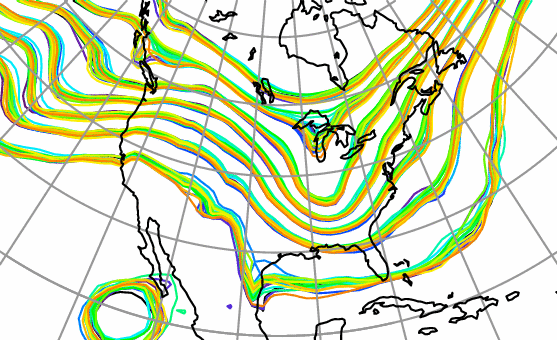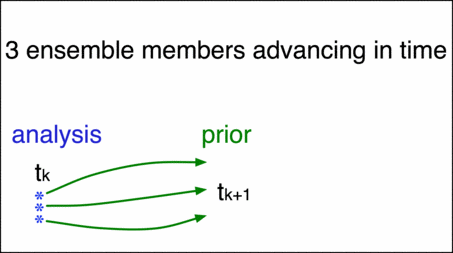Welcome to the Data Assimilation Research Testbed
The Data Assimilation Research Testbed (DART) is an open-source, freely available community facility for ensemble data assimilation (DA). 1 DART is developed and maintained by the Data Assimilation Research Section (DAReS) at the National Center for Atmospheric Research (NCAR).
Ensemble Data Assimilation
Ensemble DA is a technique for combining observations with numerical models to estimate the state of a physical system.
It enables modelers, observational scientists, and geophysicists to:
Generate initial conditions for forecasts.
Create a retrospective estimate of the state of a system, a practice known as producing a reanalysis.
Assess the relative value of specific observations on forecast skill, a practice known as conducting an observing system experiment (OSE).
Estimate the value of hypothetical observations in order to inform the design of an observing system, a practice known as conducting an observing system simulation experiment (OSSE).
Determine a model’s systematic bias in estimating the state of a system, a practice known as diagnosing model error.
The DART software environment makes it easy to explore a variety of data assimilation methods and observations with different numerical models. It provides powerful, flexible DA tools that are easy to use and customize to support efficient and reliable DA applications. While DART is primarily oriented for DA research, it has also been used in operational settings.
DART includes:
A comprehensive tutorial introducing the concepts of ensemble DA.
Extensive documentation of its source code.
Interfaces to a variety of models and observation sets that can be used to introduce new users or graduate students to ensemble DA.
DART is also designed to facilitate the combination of assimilation algorithms, models, and real or synthetic observations to allow increased understanding of all three. It provides a framework for developing, testing, and distributing advances in ensemble DA to a broad community of users by removing the implementation-specific peculiarities of one-off DA systems.
These tools are intended for use by the full range of geosciencies community: beginners and experts; students and teachers; national centers and university research labs.
Organization of the documentation
Because of DART’s extensive scope, this documentation is detailed and carefully organized, enabling you to easily find the information you need. If you have any questions or suggestions for improvements, please contact DAReS staff by emailing dart@ucar.edu.
The documentation is partitioned into three parts:
a user guide that explains how to install DART and perform data assimilation
source code documentation that provides a detailed description of the programs and modules in the repository
a comprehensive description of data assimilation theory
Manhattan Release
DART releases are named based on the major version number. The current version, 9.x.x, is the Manhattan release. Email dart@ucar.edu for advice if you are interested in a model which has not been converted from the previous Lanai release.
Quick-start
DART is available through GitHub. To download the latest version of DART, use:
git clone https://github.com/NCAR/DART.git
Go into the build_templates directory and copy over the closest
mkmf.template._compiler.system_ file into mkmf.template.
Edit it to set the NETCDF directory location if not in /usr/local or comment
it out and set $NETCDF in your environment. This NetCDF library must have been
compiled with the same compiler that you use to compile DART and must include
the F90 interfaces.
Go into models/lorenz_63/work and run quickbuild.csh.
$ cd models/lorenz_63/work
$ ./quickbuild.csh
If it compiles, run this series of commands to do a very basic test:
$ ./perfect_model_obs
$ ./filter
If that runs and you have Matlab installed on your system add
DART/diagnostics/matlab to your matlab search path and run the
plot_total_err diagnostic script while in the models/lorenz_63/work
directory. If the output plots and looks reasonable (error level stays around 2
and doesn’t grow unbounded) you have successfully installed DART and completed
your first assimilation with it.
If you are planning to run one of the larger models and want to use the Lorenz
63 model as a test, run ./quickbuild.csh -mpi. It will build filter and any
other MPI-capable executables with MPI.
Important
The mpif90 command you use must have been built with the same version of
the compiler as you are using.
If any of these steps fail or you don’t know how to do them, go to the DART project web page listed above for very detailed instructions that should get you over any bumps in the process.
Quick-start for developers
To create a fork of DART for your own development you will need a GitHub account.
fork the NCAR/DART repo on GitHub
clone your (new) fork to your machine - this will set up a remote named ‘origin’.
git clone https://github.com/USERNAME/DART.git
where USERNAME is your GitHub username.
create a remote to point back to the NCAR/DART repo. Convention dictates that this remote should be called ‘upstream’
git remote add upstream https://github.com/NCAR/DART.git
Use ‘upstream’ to keep your fork up to date with NCAR/DART. GitHub has documentation on working with forks.
Download one of the tar files (listed below) of ‘large’ files so you can test your DART installation.
If you want to contribute your work back to the DART community, create a feature branch with your work, then issue a pull request to propose changes to NCAR/DART.
There are several large files that are needed to run some of the tests and examples but are not included in order to keep the repository as small as possible. If you are interested in running bgrid_solo, cam-fv, or testing the NCEP/prep_bufr observation converter, you will need these files. These files are available at:
Release |
Size |
Filename |
|---|---|---|
“Manhattan” |
189M |
|
“wrf-chem.r13172” |
141M |
|
“Lanai” |
158M |
|
“Kodiak” |
158M |
|
“Jamaica” |
32M |
|
“Hawaii” |
32M |
Download the appropriate tar file and untar it into your DART repository. Ignore
any warnings about tar: Ignoring unknown extended header keyword.
Citing DART
Cite DART using the following text:
The Data Assimilation Research Testbed (Version X.Y.Z) [Software]. (2019). Boulder, Colorado: UCAR/NCAR/CISL/DAReS. http://doi.org/10.5065/D6WQ0202
Update the DART version and year as appropriate.
References
- 1
Anderson, J. L., T. Hoar, K. Raeder, H. Liu, N. Collins, R. Torn and A. Arellano, 2009 The Data Assimilation Research Testbed: A Community Facility. Bulletin of the American Meteorological Society, 90, 1283-1296, doi:10.1175/2009BAMS2618.1
Getting started
What is data assimilation?
What is DART?
Run DART with your model
- Working with collaborators on porting new models
- Assimilation in a complex model
- Message Passing Interface
- Filters
- Inflation
- Required model_mod routines
- Suggestions for a “simple” model
- Suggestions for a “complex” model
- How to test your model_mod routines
- Controlling which files are output by filter
- Advice for models with multiple vertical coordinate options
- Data management in DART
- Programs included with DART
Observations
- Adding your observations to DART
- How DART supports different types of observations: the preprocess program
- How DART stores observations: observation sequence (obs_seq) files
- Detailed structure of an obs_seq file
- Creating an obs_seq file of synthetic observations
- Creating an obs_seq file from real observations
- Available observation converter programs
- Manipulating obs_seq files with the obs_sequence_tool
- The difference between observation TYPE and QUANTITY
- Adding support for a new observation TYPE
- Radiances
Observation Converters
Diagnostics
Contributing and Community
Guide

